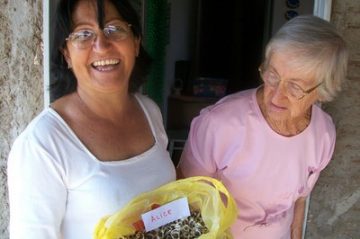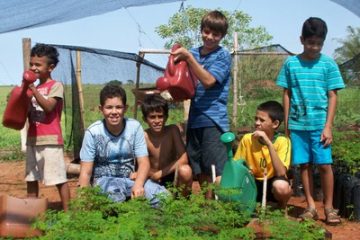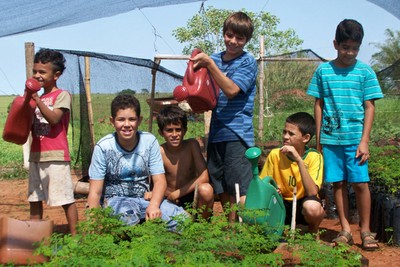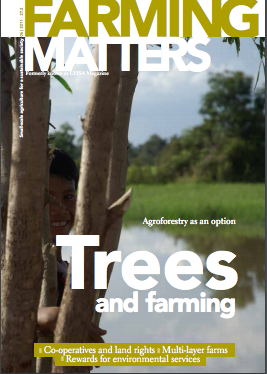We enjoy our individual interactions with farmers and often develop personal relationships with each one of them as they proceed through our training programmes, but we have found that we are more successful when we work with groups of people who want to develop agroforestry projects. It is more efficient to work with groups. It also maximises our use of limited funds by ensuring that workshops and field visits reach the largest number of people possible.

Four communities
When we started our work in Brazil in 2008 we went to meet small-scale farmers’ associations and agricultural co-operatives to assess their interest in agroforestry. Because of the Federal Government’s ongoing initiatives to restore forest cover, many people were instantly interested. They liked the idea of planting trees that met the requirements for reforestation and that could be used for purposes such as feeding cows and reducing erosion. We started by working with several honey producing associations and agricultural co-operatives. But despite being part of an organised association or co-operative, most farmers were geographically isolated, and this made it difficult to conduct workshops, to provide regular assistance and get the participants to exchange information.
In 2009 we decided to work with associations that are more community-based, rather than the larger and more geographically dispersed groups we worked with in 2008. We chose to focus on four communities within the state of São Paulo. Three of the communities (Guaranta, Promissão Reunidas, and Promissão Dandara) are Landless Movement Settlements, while one community (Arco Iris) is an Indigenous Settlement. All of the communities can be reached by gravel road and each has a small town centre (of less than 35,000 people) within 20 kilometres. They are all approximately 400 km from the city of São Paulo. We work with between ten and one hundred individuals in each community; in each of the four communities there is a history of people working together to accomplish specific goals, such as gaining land titles. We have found that this community spirit improves their personal relations, as well as with our organisation, and has led to excellent project results.
Community-members identified the production issues that they wanted to address by starting agroforestry projects. In each case, our team worked with individuals to identify techniques and species that would improve their production systems. The main project objectives in these communities are increased and diversified production, reduced erosion and improved water availability. Each individual chose fast growing, multiple purpose tree species to plant in windbreaks, live fences, and fodder plots, as well as along waterways and in private forest reserves.
More than proximity

The importance of working with a group is evident since individuals hold each other accountable for completing our training courses. This was seen during a recent site visit to Guaranta, when our staff arrived at the house of Cida and Zezão. Members of three families sat around their table reviewing the training materials and discussing specific questions. When asked why they were reviewing the materials they stated that they knew the community could only go forward with the project if most of them completed the course. They wanted to be sure that they had all fully understood what we were all talking about.
Sometimes we find it difficult to reach individuals within the communities during site visits. In these situations, we can rely on other community members to help us distribute seeds and information. They also provide updates on who is having trouble with their nurseries and can direct us to people who have specific questions. We have found communication and the co-ordination of the projects to be much more efficient and effective as a result of the tight bond found among the project participants.
No easy start
Initially we faced a lot of scepticism about our approach and our projects. Many people found it hard to believe that trees could benefit agricultural production. We addressed concerns about the loss of land for trees in our meetings and workshops in two ways. First, we tried to honestly outline how long it would take to receive benefits from the trees that people chose. Second, we relied on the results of previous TREES projects in other countries to show what can be done and what benefits result from planting efforts. The first few years were difficult because many people chose not to participate. We found that examples from other countries were not accepted as proof. People did not believe that techniques that worked in other countries would work on their land.
However, we did find some individuals who wanted to try, and they have started to see the benefits of their efforts. We are confident that our programme will continue to grow as more participants benefit from trees. The opportunity for people to see the projects in action, and for people to share information about their work, have been essential in the growth of our programme.
Other benefits
There are many advantages of working with organised groups. There are several government programmes (like Bolsa Família and the Direct Local Purchase programme) that purchase products from communities. As agroforestry improves production, working together helps these communities sell a higher quantity of quality products. Larger issues such as the reforestation of waterways and legal reserves also benefit from a community approach. Although each agroforestry project is an individual effort on private land, it would be harder to address these larger issues if everyone was only working individually.
Through working with a group we can help co-ordinate efforts to ensure that we take a landscape approach and that individuals do not have a negative effect on each others efforts. For example, if we work with a group of people with land within the same water catchment, this will have more effect in improving the quality of the water. If we only worked with one individual, the benefits of the effort could be offset by another person’s unsustainable land management practices.
When we met with people in these four communities one of their greatest complaints about agricultural projects was that an extensionist might show up once in the community, hands out materials but then never return to see how things develop. Our field staff have been absolutely crucial in alleviating fears about the commitment of TREES to these communities. People see our technician visiting every week or two and understand that we consider ourselves to be part of the community effort to address economic, social, and environmental issues. We often hear people joking with one another about not completing the next step in the project. Part of that joking usually includes a reference to our staff visiting the community and how bad it would look if they were lagging. It is apparent that there is a certain level of social and peer pressure which helps ensure the projects are completed.
Not long ago, an official from the government agency responsible for landless settlements in São Paulo attended a TREES presentation. He did not believe all of the results that had been presented so he went to visit individuals in Guaranta. To the official’s surprise, the community confirmed that we had assisted them by helping to plant trees. In the 2010 nursery season almost one hundred project participants transplanted approximately 120,000 seedlings to diversify their incomes and improve yields, improve nutrition or conserve soil and water. In early 2011 participants direct seeded another 340,000 plants for agricultural production and 70,000 plants for conservation. Our relationship with participating communities is essential in enabling us both to achieve such positive results.
Putting principles into practice
We have found a direct relationship between the proximity of people, the strength of a community and the success of agroforestry projects. Our organisation’s relationship with communities and the resulting trust has increased our ability to reach people and to work toward improved agricultural production, increased conservation and enhanced nutrition.
There is a tendency for projects to get more impersonal as they increase in size and become more geographically dispersed. In response to this, we are currently working on ways to apply our communitybased approach as we expand to new areas. Constant contact with communities through field visits creates an environment for open communication and will produce a feedback system that allows communities to guide the projects. Being part of the community allows us to identify risks and make appropriate adaptations to ensure that people’s needs are met and that we build upon the motivation of the people with whom we work.
Text: Jeff Follett
Jeff Follett works as the South America Programme Officer in Trees for the Future. E-mail: jeff@treesftf.org. More information about their work can be found on their website: www.plant-trees.org


